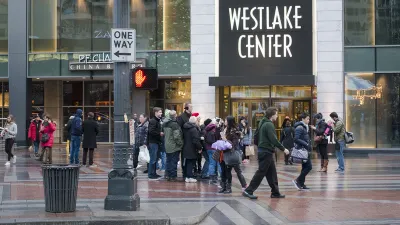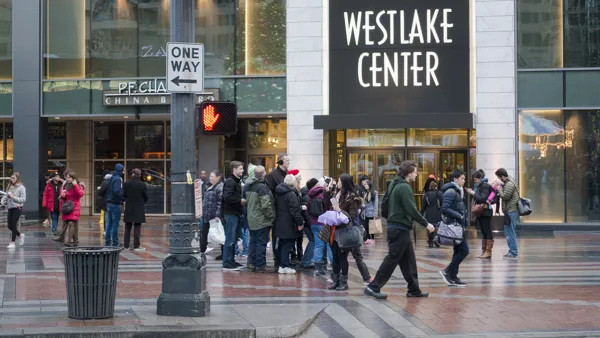With the plan update process for Seattle's Pedestrian Master Plan underway, one writer wonders why the plan is setting firmer goals for increased mode share.

Ryan Packer offers a critique of the Pedestrian Master Plan update currently underway at the Seattle Department of Transportation (SDOT). Noting that the number of commuters walking to work grew by 50 percent between 2010 and 2015, Packer determines that the plan update is disappointingly short on the kinds of goals that can further that progress.
For instance, Packer points out that the Pedestrian Master Plan lacks mention of the city's Vision Zero goal for 2035, and instead, "the goal is laid out as a decreasing rate of pedestrians involved in crashes."
Although Packer acknowledges the good intentions of the plan update, which includes mentions of pedestrian mode share, transit ridership, kids walking to school, and streetscapes, "without concrete goals to tell us just how successful our master plan is, we won’t be able to truly gauge success or failure."
Against this backdrop, Packer contrasts the Move Seattle levy, approved by voters in November 2015. That levy has a dashboard and a number of concrete targets to help residents track the success of that $930 million effort.
Back in August 2016, Packer also critiqued the implementation of the current version of the Pedestrian Master Plan, approved in 2009, focusing mostly on issue of maintenance and operations.
FULL STORY: Seattle’s Pedestrian Master Plan Is Short On Concrete Goals

Analysis: Cybertruck Fatality Rate Far Exceeds That of Ford Pinto
The Tesla Cybertruck was recalled seven times last year.

National Parks Layoffs Will Cause Communities to Lose Billions
Thousands of essential park workers were laid off this week, just before the busy spring break season.

Retro-silient?: America’s First “Eco-burb,” The Woodlands Turns 50
A master-planned community north of Houston offers lessons on green infrastructure and resilient design, but falls short of its founder’s lofty affordability and walkability goals.

Test News Post 1
This is a summary

Analysis: Cybertruck Fatality Rate Far Exceeds That of Ford Pinto
The Tesla Cybertruck was recalled seven times last year.

Test News Headline 46
Test for the image on the front page.
Urban Design for Planners 1: Software Tools
This six-course series explores essential urban design concepts using open source software and equips planners with the tools they need to participate fully in the urban design process.
Planning for Universal Design
Learn the tools for implementing Universal Design in planning regulations.
EMC Planning Group, Inc.
Planetizen
Planetizen
Mpact (formerly Rail~Volution)
Great Falls Development Authority, Inc.
HUDs Office of Policy Development and Research
NYU Wagner Graduate School of Public Service



























